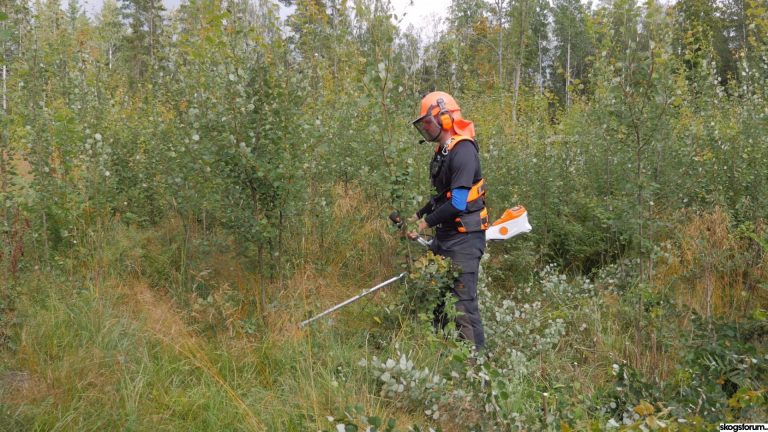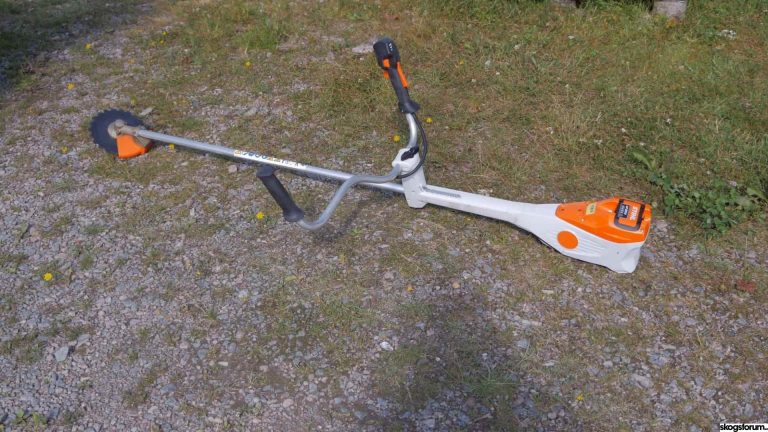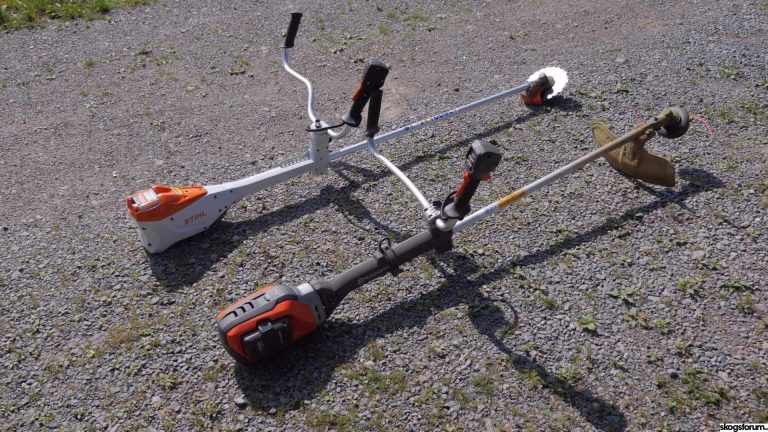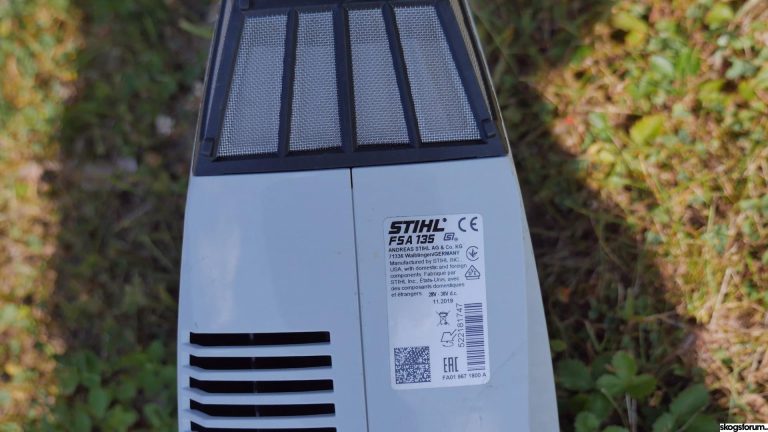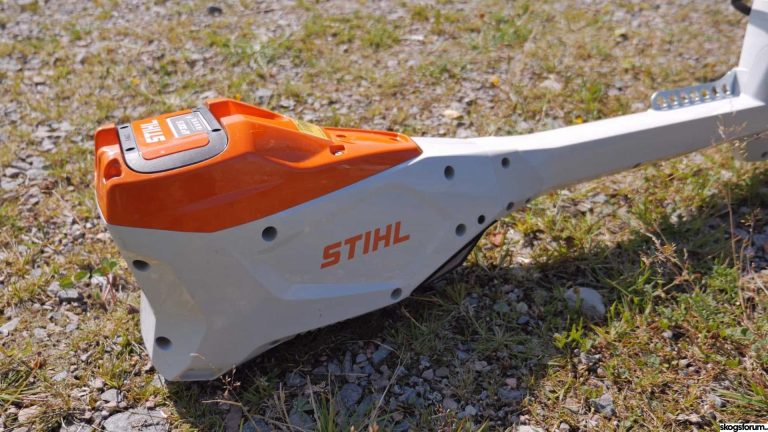In early March this year Stihl announced the release of a new series of battery powered tools for forestry and garden. Stihl FSA 135 is one of the products in the new series. We have chosen to focus on that as it is suitable for pre-commercial thinning in the northern hemisphere. Fredrik at Skogsforum.se performed a first test of the Stihl FSA 135 and this article is a summary of his impressions of the saw.
Testing Stihl FSA 135
Just like Husqvarna’s battery powered clearing saw, that we tested a while ago, the Stihl FSA 135 is meant to be a combination of grass trimmer and clearing saw, but mainly a grass trimmer. This becomes obvious when you have a look at what tools that included as standard in the price of the FSA 135 (only a trimmer head). But, just like the Husky, the gear offers the possibility to also mount a circular saw blade or a brush knife. And yes, the Stihl FSA 135 has a gear at the end of the drive tube instead of an electrical motor.
In this test, we focused on the clearing saw version of the Stihl FSA 135.
A combi machine – not good for anything?
Combination machines are often accused of being products that are not good at anything, except for compromises. What about the Stihl FSA 135? We (Fredrik) only tested the FSA 135 in the forest, equipped with a saw blade. The compromise here is the slightly longer drive tube and larger angle on the gear.
Whether this affects the user or not, we choose to leave unsaid. The experienced pre-commercial thinner probably wants a smaller angle on the gear and perhaps also a shorter drive tube. For those who doesn´t use the saw on a daily basis, it probably doesn’t matter at all.
Battery compared to gas – the hot question!
At the Swedish discussion (and sister-) site Skogsforum.se there are few subjects that tear up as much emotions as battery contra gas for working tools in the forest. To have different points of view is normal, but why is this subject so hot? Someone must do some research on that. We will not …
There are some points worth mentioning in this matter. The FSA 135 corresponds to a 35-cc gas clearing saw. This is good to know if you consider buying a battery saw in the future. The Stihl FSA 135 works, just like the Husky 535 iFR, excellent in early pre-commercial thinning. It shows no signs of weakening and is without doubt comparable with a gas driven saw in the same size.
Of course, we tried the FSA 135 also in thicker thinning. In the test, the FSA 135 could also handle this, but you have to settle for a 200-mm blade as a 225-mm don´t fit on the FSA 135. Stems over 10 cm diameter (4”) is tough for the FSA 135 even if the power is there. It´s more about torque. We also noticed that the drive tube isn´t built for these stem sizes. The risk of bending the tube is however small as we see it.
Stihl FSA 135 vs. Husky 535 iFR
The differences between the Stihl FSA 135 and the Husqvarna 535 iFR are small. According to our tests they are similar in performance and battery time. As for the battery time, it was a bit warmer when we tested the FSA 135, so the battery on the 535 iFR might last a little longer under the same conditions. On the other hand, the Stihl batteries (AP 300S) charges faster than the Husqvarna batteries (BLi 300). Approx. 30 minutes with the largest Stihl charger.
The weights are also quite similar. The Husky is some grams lighter than the Stihl, with both saws equipped with the largest available batteries. The functions and designs are similar on both saws, and both can cope with a limited amount of moist and rain. Stihl has chosen not to classify the FSA 135 according to the IP-standard, as the Husqvarna has IPX4-classification. Most likely they are equivalent also on this.
The 535 iFR has a 28-mm drive tube as the FSA 135 has a 26-mm ditto. This makes the 535 a bit more stable when working with thick stems. Still, the differences are small. The same goes for the harness that comes with the price. Here we strongly recommend to go for a professional harness (in both cases) if you are to work in the forest.
Benefits with the Stihl FSA 135 and battery saws in general
When you are working in young pre-commercial thinning the output of the saw is not that important. When you work full time with a clearing saw, the weight of the saw could be important.
According to sales statistics, Stihl FS 460 and Husqvarna 545 are the most common clearing saws. Both weighs, with full tank, approx. 10 kg. The battery saws mentioned in this article weighs approx. 7 kg. That´s 25 % less weight to carry during a full day’s work if you use the battery powered alternative. That is something to bear in mind.
To start a battery saw is easy. You don´t have to pull the starter rope (“the heart attack rope”) meaning that everyone can use a battery saw. When you release the throttle trigger, the saw is completely silent. Also, when the saw is running, it´s silent compared to a gas driven saw.
Maybe the biggest advantage is that you don´t have to inhale or smell the exhaust gases.
Is the Stihl FSA 135 something for you?
Based on our test we claim that the FSA 135 could be something for the private forest owner with not so much, and not so thick, pre-commercial thinning annually. If you in addition to forest work do a lot of grass trimming, this could be the perfect saw for you.
This is not a product for the professional thinner that also works in thicker stands (+7 cm diameter). For those, a gas driven saw is a better option. If nothing else, you can use a larger saw blade with a gas driven saw which is more efficient.
Something to bear in mind is that the manufacturers create systems around their batteries meaning that you must stick to the brand you have chosen from the start. The gas driven saws could be filled with any brand of gas. The good thing about the battery systems is that you can use the same battery for your chain saw, clearing saw, hedge trimmer, grass trimmer, lawn mower and more, as long as you stick to the same brand.
Film
Here is a film from the test – in Swedish:
Film & photos: Skogsforum.se






